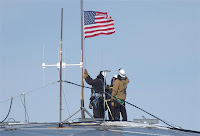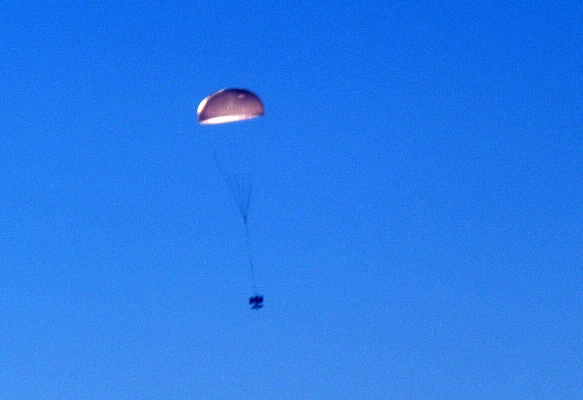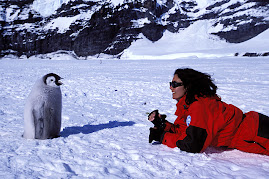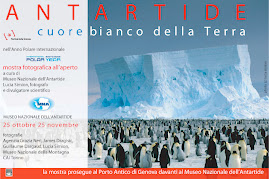
Même une mère et son petit...massacrés....! Quand la viande de baleine sera-t-elle INTERDITE sur les marchés?? Ce que fait la flotte de baleiniers japonais dans l'Océan Austral est accablant et révoltant.
SYDNEY (AFP) — Le gouvernement australien a affirmé jeudi détenir des photos accablantes de chasse à la baleine, qui pourraient venir appuyer une action en justice contre la pêche japonaise en Antarctique, des documents qualifiés de "propagande" mensongère par les Japonais.
L'une des photos montre une femelle et son petit en train d'être hissés à bord d'un baleinier japonais, après avoir été harponnés.
"Quand j'ai vu ces photos, j'ai eu des hauts le coeur et en même temps, j'ai éprouvé un sentiment de grande tristesse", a déclaré le ministre de l'Environnement australien, Peter Garrett, l'ancien chanteur du groupe de rock Midnight Oil.
"C'est vraiment accablant quand vous pensez qu'il faut jusqu'à quinze minutes pour qu'une baleine succombe après avoir été harponnée. C'est encore pire de voir qu'il y a un baleineau", a-t-il également déclaré.
La profonde blessure du jeune cétacé, appartenant à l'espèce des baleines de Mink, qui a répandu une mare de sang dans la cale du navire, semble avoir été causée par un harpon à explosifs.
Cette série de photos a été prise à partir d'un bâtiment des Douanes australien qui suit en ce moment les baleiniers japonais dans les eaux de l'Antarctique, dans l'objectif de recueillir des éléments pour soutenir une action judiciaire internationale.
"Elles vont nous aider à bâtir la procédure dont les détails sont encore en cours d'examen, afin de dire que la chasse aux baleines doit s'arrêter", a déclaré à la presse le ministre en charge des douanes, Bob Debus.
Côté japonais, l'institut de recherche sur les cétacés 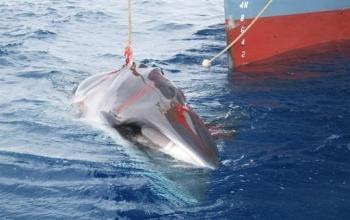 a répliqué en accusant l'Australie de mener une campagne de "propagande jouant sur l'émotion".
a répliqué en accusant l'Australie de mener une campagne de "propagande jouant sur l'émotion".
Le directeur de cet institut financé par le gouvernement japonais et partie prenante de la chasse à la baleine, Minoru Morimoto, a prévenu que l'attitude australienne "pourrait provoquer de graves dommages" aux relations entre les deux pays.
Il a assuré que les deux baleines de la photo n'étaient "pas une mère et son petit", jugeant important de ne pas "tromper l'opinion australienne en diffusant de fausses informations".
L'Australie est l'un des pays fer de lance de la lutte contre la chasse aux baleines du Japon. Tokyo exploite une faille dans le moratoire sur la pêche commerciale de 1986, en arguant que ses prises ont des visées scientifiques.
Des baleiniers japonais croisent dans l'Antarctique depuis décembre pour tuer un millier de cétacés. Ils ont été contraints de suspendre leur campagne à la mi-janvier pendant plusieurs jours, sous la pression de défenseurs des baleines venus dans la zone. Ils ont depuis repris leur pêche, les navires des écologistes ayant dû repartir faute de carburant.
PHOTOS ET TEXTE: Agence France Presse
 This graphic shows how the ice particles and water vapor observed spewing from geysers on Saturn's moon Enceladus may be related to liquid water beneath the surface. The large number of ice particles and the rate at which they are produced require high temperatures, close to the melting point of water. These warm temperatures indicate that there may be an internal lake of liquid water at or near the moon's south pole, where the geysers are present.
This graphic shows how the ice particles and water vapor observed spewing from geysers on Saturn's moon Enceladus may be related to liquid water beneath the surface. The large number of ice particles and the rate at which they are produced require high temperatures, close to the melting point of water. These warm temperatures indicate that there may be an internal lake of liquid water at or near the moon's south pole, where the geysers are present.








